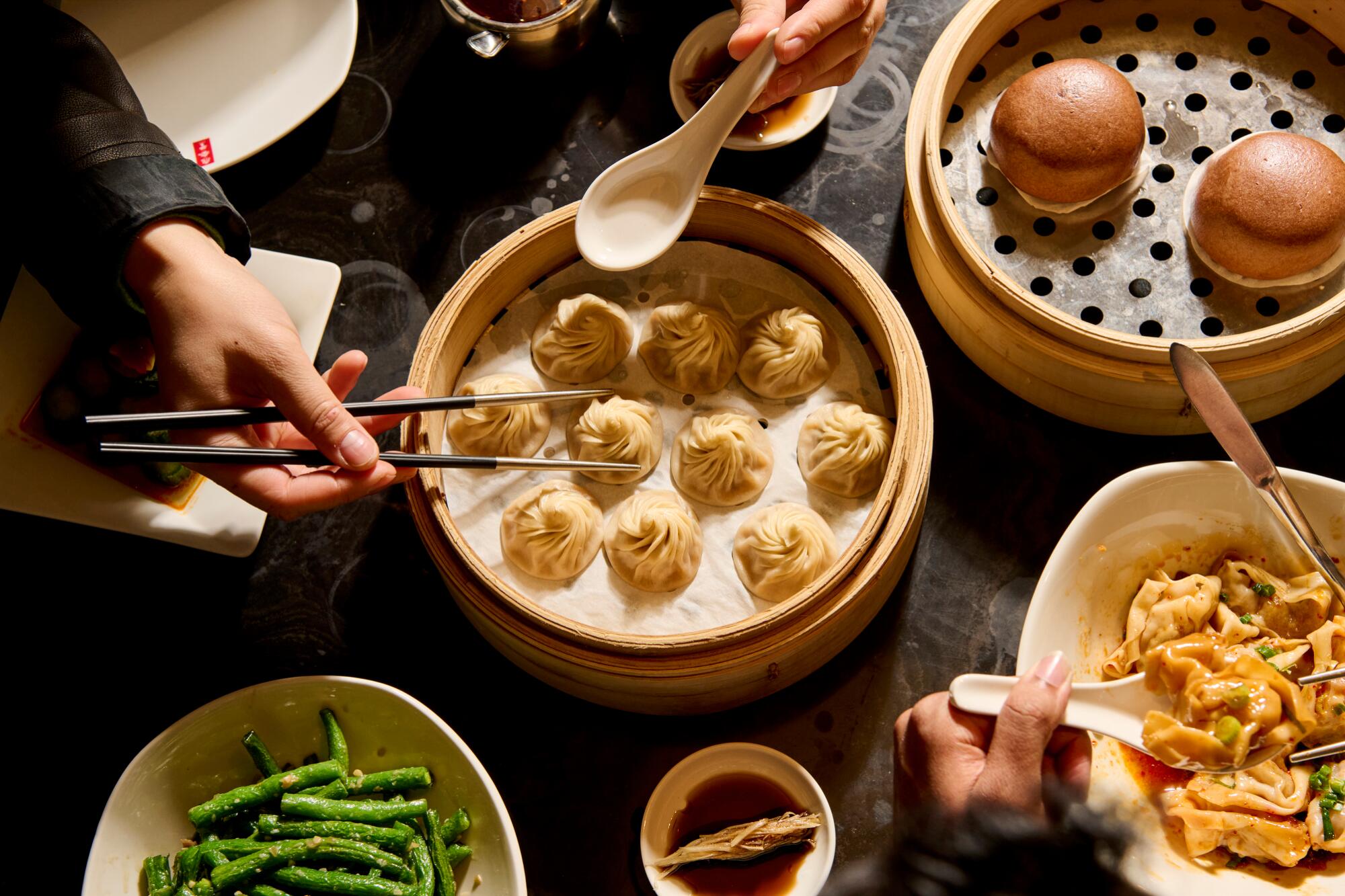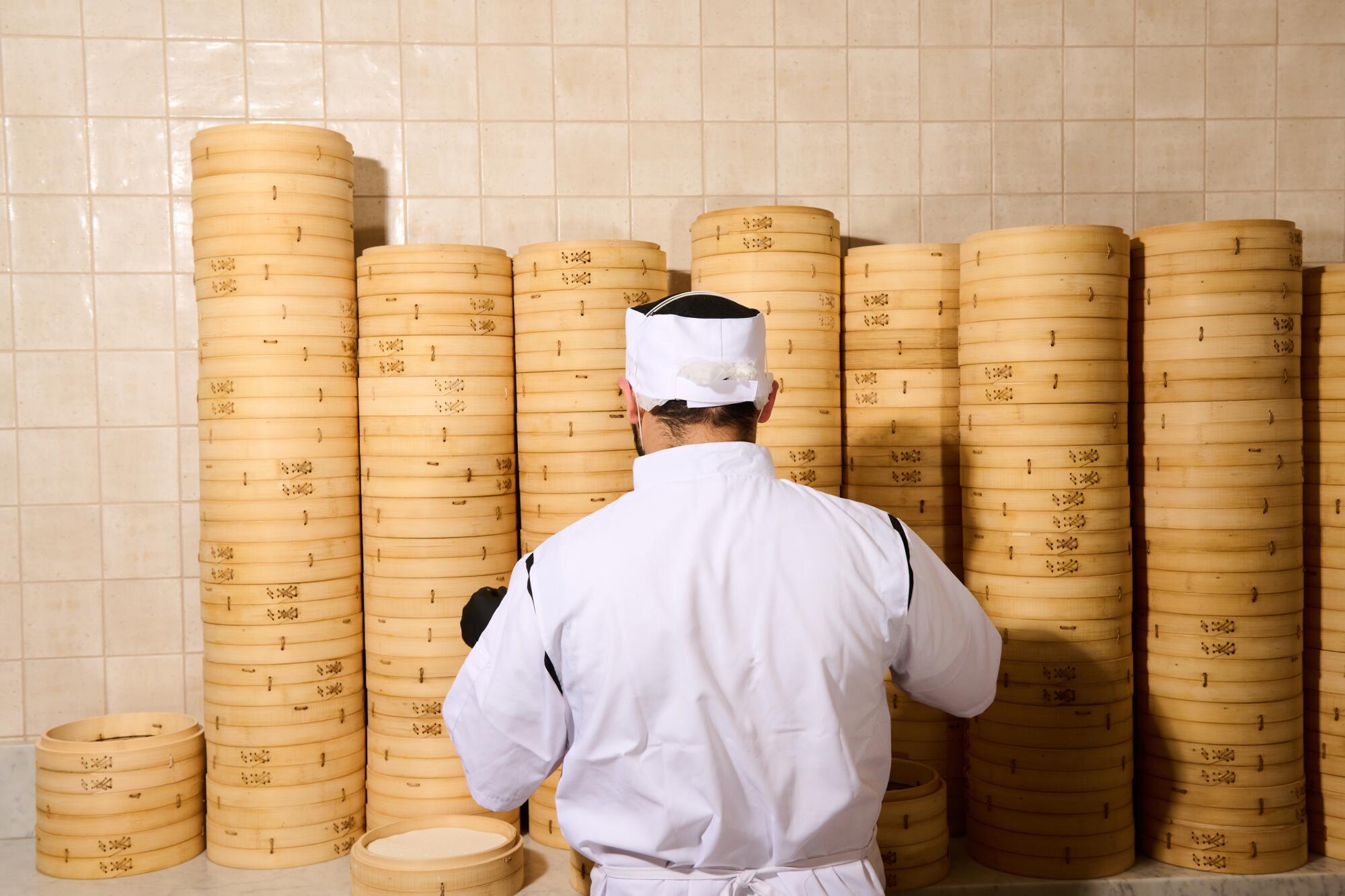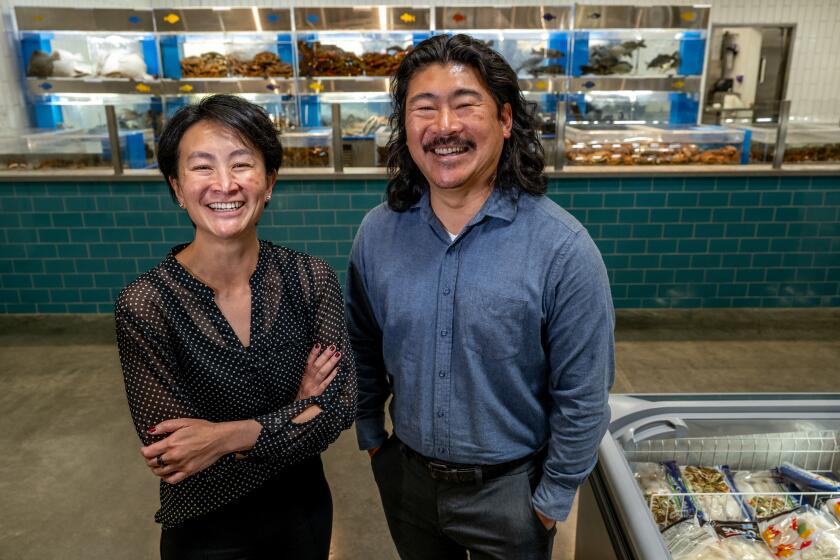
- Share via
I’m standing in front of a Din Tai Fung located inside a shopping mall in Taipei watching a team of seven masked chefs in stiff white coats behind a glass window — kneading, filling, weighing, dusting and pleating dough underneath fluorescent lights.
Kan Kuang-Ming, head chef of Din Tai Fung Taiwan, is at the center, head down, shoulders scrunched up, crimping dumplings. He cups dough and filling with his left hand and, with his right, makes a twisting series of dexterous pinches to form a perfect swirl. I count how long it takes him to fold one dumpling: eight seconds.

“When you look outside from the glass, it looks straightforward,” he tells me. “But if you try it yourself, you realize how difficult it is.” Kan has been at Din Tai Fung for 21 years. “I started when I was 18 years old,” he says.
Din Tai Fung has churned out consistently popular batches of soup dumplings for more than 50 years. With 170 locations in over a dozen countries, the Taiwanese chain commands daily long lines, attracting customers mesmerized by the glassed-in kitchen where parcels of dough and meat are meticulously shaped and assembled in real time.
The chain is steadily conquering America, thanks to the efforts of the founding family’s next generation.
Since its North American debut in California over two decades ago, the chain of restaurants has been concentrated exclusively on the West Coast. Last month in Glendale, Din Tai Fung relocated from the Americana at Brand to the Galleria, occupying a behemoth 11,443-square-foot space. A Downtown Disney location is planned for sometime next year, and most notably, the company recently signed a 15-year lease to open in New York, which will mark the first East Coast location in its portfolio.
Din Tai Fung in Glendale will move from the Americana at Brand to the Galleria in 2023, opening its largest L.A. County location yet.
Each Din Tai Fung restaurant produces an average of 10,000 dumplings a day. It’s an operation that requires the manpower of roughly 30 chefs on rotation, all of whom are required to master the art of the perfect fold. It’s this attention to detail that has ensured Din Tai Fung’s reign as one of the most successful dumpling chains in the world.

Kan says it took him three months to learn how to properly fold a soup dumpling that was up to the standard.
For brothers Aaron and Albert Yang, it took them twice as long to get it right. “It took us at least six months to a year to perfect the craft and finally be able to make some dumplings that could be sold,“ Albert says.
Aaron and Albert are the third-generation custodians of Din Tai Fung. Both vice presidents at Din Tai Fung USA, they are charged with overseeing the Taiwanese dumpling chain’s presence in the American market. “The more high-profile, the more high-foot-traffic locations there are, the more we’re able to share our food and culture,” says Albert.

Xiao long bao, or soup dumpling, hails from the greater Shanghai region in China and according to Chinese lore, was invented sometime between the 18th and 19th century. A bundle of gently seasoned pork and broth, it reflects the light and delicate sensibilities of the region’s cuisine. But while it is a specialty of eastern China, it truly wasn’t until Din Tai Fung came along that it became a worldwide phenomenon.
With its papery thin skin and a sticky blend of ground pork and gelatinized broth, the soup dumpling is one of the most difficult dumplings to put together. Roll out too thin of a skin or pinch an imperfect crimp and the broth will leak through. Too thick and the dumpling loses all of its allure. In order to hold the filling, the center of the skin must be a couple of hairs thicker than the edges. And at Din Tai Fung, each dumpling has to follow an exact standard: 18 folds, 21 grams apiece. A seasoned chef should be able to fold an average of eight dumplings in one minute.
“A dumpling chef needs to have a lot of patience,” Kan says. “You have to fail about 1,400 times before you can make one that is beautiful.”
The company was founded by Aaron and Albert’s grandfather, Yang Bing-Yi, a Chinese immigrant who moved to Taiwan in his 20s during the Chinese Civil War in 1927. Originally a nondescript cooking oil store in Taipei, the shop transitioned into an eatery when Yang hired a Shanghai-born chef and started selling soup dumplings.
Din Tai Fung, the restaurant, formally opened in 1972, and eventually drew the attention of international food critics and chefs who gushed about its “flavorful fillings and light, thin dough.” In 1995, the elder Yang retired and his children took over.
From a very young age, Aaron and Albert were shown the ins and outs of the family business. Though they were raised in Los Angeles, they would visit Taiwan often, and would spend their vacation hanging out at their grandfather’s restaurant. The chefs would pinch swans out of the dough for them and whisk them around the city. “We were just little babies and they would take us around on their motorcycles,” Albert recalls.
When their father, Frank Yang, opened up the first American Din Tai Fung in Arcadia in 2000, the brothers were given a bit more responsibility.

“[My father] saw a Din Tai Fung in the U.S. that was using the brand without our permission,” Aaron says. “It kind of inspired him to open his own Din Tai Fung here and just show people what the real product is like.”
It was an instantaneous hit.
“We were running credit cards when we could barely even see over the counter,” Aaron says. By the seventh grade, they were learning how to fold the dumplings themselves.
Eventually, both the Yang brothers went on to get degrees in hospitality administration at Cornell University, and today spearhead the multimillion-dollar dumpling empire’s outposts in America. Aaron focuses on business development and Albert on the food and operations.
“Our personalities are a bit different, but it’s great for the business because we just split duties,” says Albert.
Like the Yangs, I also grew up in Arcadia. I vividly remember the daily snaking lines that formed outside of that first Din Tai Fung. Situated in a cramped strip mall with a long green awning and “Din Tai Fung Dumpling House” spelled out in bold, forest-green font, it was the most popular attraction in town for more than a decade.

Snagging a seat was consistently difficult, so my mom would call in ahead of time on the weekdays and pick up a takeout order of dumplings for my brother and me to enjoy as an after-school snack.
The wait was especially long on the weekends, as folks from all over Greater Los Angeles made the trek just for the papery-thin dumplings.
“There’s something to be said about just how universally liked it is by people from all different cultures and ethnic backgrounds,” says Aaron.
The Glendale branch, which opened 13 years after the Arcadia location, was established while the Yang brothers were attending college. “My dad opened another location after knowing his kids were going to college for hospitality management,” Aaron says. “It gave him the confidence to know the next generation is at some point ready to take the reins.”
They grew up at the nearly 40-year-old Asian grocery chain in the San Gabriel Valley. Now, siblings Alice and Jonson Chen are overseeing the national expansion of 99 Ranch Market.
Since then the Yang brothers have made some improvements, like launching an online waitlist and reservation system, modernizing a training manual and providing above-average wages for their staff.
“Our entry-level hourly positions start at $20 an hour and the managers start at $100,000 annually,” Albert says. And whereas aspiring Din Tai Fung chefs in Taiwan pick up the trade by shadowing a senior chef, incoming dumpling masters in the United States are instead enrolled in a training program.
“Our current training program is 12 weeks, though it still takes six months and up to a year to get up to speed,” says Albert. “Every single one of our restaurants in the United States has a dumpling training manager, and that manager is solely dedicated to training the team and ensuring the quality and consistency behind the 18 folds and ensuring that each dumpling weighs 21 grams.”
Half a century since its debut, the Yangs say that keeping the food consistent and traditional is what sets them apart.
“I still remember someone coming up to my dad and asking him why we don’t do a cheeseburger soup dumpling,” Aaron says. “But that would change the essence of what the food is. We have always just felt strongly that the food should be authentic to Taiwan, where we originated from.”

Clarissa Wei is a writer and cookbook author. Her book, “Made in Taiwan: Recipes and Stories from the Island Nation” (Simon & Schuster), was published this fall.
More to Read
Eat your way across L.A.
Get our weekly Tasting Notes newsletter for reviews, news and more.
You may occasionally receive promotional content from the Los Angeles Times.












